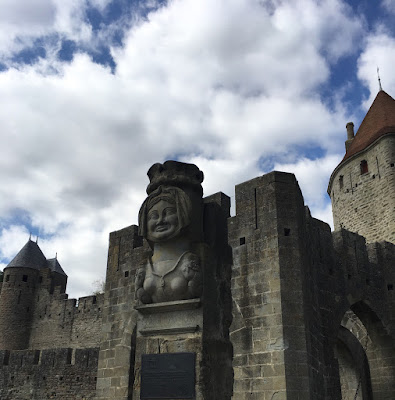After spending our first morning in the newer section of Carcassonne, it was time to venture up the hillside to the old, walled city. And when I say old, I mean really old. The first colony on the site (that we know of) was founded by the Romans (who else?!) in 118 BC. Yes, BC — I said it was old!
 |
| One corner of the walled city |
The castle wasn't constructed as we know it around 1130AD, but by then much of the walled city had been erected. The city and castle have undergone many re-builds, but it is more or less organized and looks as it would have originally.
 |
| Effigy of Dame Carcas |
Carcassonne is very near the Spain/France boarder and therefore it was often under siege and even taken by the other side —and by other side, I simply mean whichever side didn't currently hold the city. There is also the legend of Dame Carcas. Although historians think she is a fictional character, the legend takes place in the 8th century, during the wars between Christians and Muslims in the southwest of Europe. At the time, Carcassonne was under Saracen rule and Charlemagne's army was at the gates to reconquer the city for the Franks. A Saracen princess named Carcas ruled the Knights of the City after the death of her husband.
 |
| Double crenelated walls and watchtowers |
The siege lasted for five years. Early in the sixth year, food and water were running out. Lady Carcas made an inventory of all remaining reserves. The villagers brought her a pig and a sack of wheat. She then had the idea to feed the wheat to the pig and then throw it from the highest tower of the city walls.
 |
| City walls and watchtower |
Charlemagne lifted the siege, believing that the city had enough food to the point of wasting pigs fed with wheat. Overjoyed by the success of her plan, Lady Carcas decided to sound all the bells in the city. One of Charlemagne's men then exclaimed: "Carcas sonne!" (which means “Carcas sounds”). Hence the name of the city.
 |
| Double crenelated walls |
The city was also known to curry favor with the cathars, an offshoot and rival religion to Catholicism. The catholics didn't like that much and also fought the city to drum out the evil cathars.
 |
| Inner wall to the left, outer wall to the right. |
Because this city was so hotly contested and prized, the builders created a double row of defensive walls, or crenelated towers. While much of the inner walls date back to the medieval period, the outer walls had been demolished. They were re-built in the late 1800s based on historical documents.
 |
| Courtyard of the castle |
Inside the walls boasts not just a city, but also a castle. The castle was built in the 12th Century for the Viscount of Carcassonne. As with all castles, it was his office as well as his family's home.
 |
| New Carcassone on the right |
Today the castle is filled with a lot of empty rooms (not very interesting to photograph), but outside there are some great vantage points across what is now the new city of Carcassonne.
 |
| Over the top crenelated wall you can see the more modern Carcassonne. |
Inside the castle boasts many sculptures and other finds that have resurfaced during renovations and re-constructions.
 |
| Wall sculptures. The far left one is quite scary |
 |
| Detailed sculpture |
 |
| Ornate doorway with creepy statue in the distance |
There were a lot of items to stop and inspect. If I had photographed them all, I would have never left the castle!
 |
| Don't blink! |
 |
| Hunting scene fresco |
Many of the tombstones below are thought to date back to crusading soldiers who didn't return home alive.
 |
| Where's Buffy when you need her? |
I liked the sculpture of the old lady so much I used her as my Facebook profile picture for a while! She looks like she was friendly, no?
 |
| My BFF |
Most of our intrepid traveler crew.
 |
| Hey! Let's go to France! |
Bill and I (far back, in the sun) with the castle behind us.
 |
| A far away shot of the two of us |
 |
| Another book at the castle |
Carcassonne even had its own amphitheater behind one of city walls. It's a fairly new build for the city, but with an amazing backdrop!
 |
| Carcassonne amphitheater |
Here's a shot of Brook being silly as we made our way to the historic cathedral.
 |
| Halt! Who goes there? |
We then made our way to the cathedral of St. Nazaire and St. Celse. This catholic church was built to appease Rome during the times of the Cathar troubles. It mostly worked.
 |
| Cathedral of St. Nazaire and St. Celse |
Construction was started on the cathedral in 1240 and the cathedral was completed in record speed - only 50 years!
 |
| Statue; perhaps of one of the saints? |
The gorgeous rose window is said to date back to the 15th century,
 |
| Rose window |
while the other panels of stained glass is said to be more recent.
 |
| More recent stained glass |
As always in a new cathedral, I stopped and light a light for my Mom. Oh how she would have loved to see the photos of all my travels! I hope that her spirit is watching and is happy for me.
 |
| A light for Mom |


















































